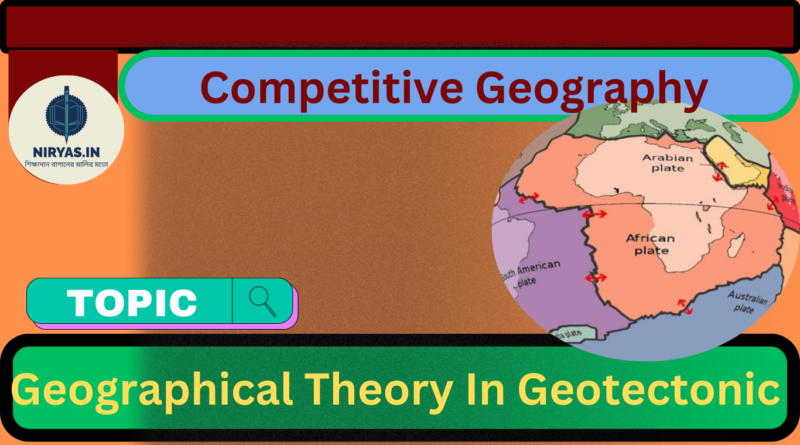Geographical Theory In Geotectonic
Geographical Theory In Geotectonic
Welcome to www.niryas.in . An important topic in competitive exam preparation is: Geography . Questions in such exams come from various topics related to the Geography. In this case, to help competitive students, we introduce the Competitive Geography section. In this section, our main goal is to present to-the-point information from various topics related to the different topics of Geography. In Competitive Geography section some topics will be completed in several parts, so click Next to read the Next Part. Currently, in the post called Geographical Theory In Geotectonic, we have presented information on various Theorys related to the Geotectonic. So, without waiting any longer, let’s take a look at the information ….
Geographical Theory In Geotectonic (Part-I)
1. Continental Drift Theory (1900s) :
◈ Proposed by: Alfred Wegener
◈ Main idea: The continents have moved over time and were once joined together in a single supercontinent, Pangaea.
◈ Key evidence: Fit of the continents, similarity of rock formations, and fossil evidence.
◈ Impact: Laid the foundation for modern plate tectonics.
➲ Alfred Wegener’s Proposal : In 1912, Alfred Wegener, a German meteorologist and geophysicist, proposed the Continental Drift Theory. Wegener observed that the continents seemed to fit together like a jigsaw puzzle and suggested that they had moved over time.
➲ Key Evidence : Wegener presented several lines of evidence to support his theory:
✧ Fit of the Continents : Wegener observed that the continents fit together like a jigsaw puzzle, with Africa and South America forming a neat fit.
✧ Similarity of Rock Formations : Wegener noted that similar rock formations were found on different continents, suggesting that these rocks had formed at the same time.
✧ Fossil Evidence : Wegener found that fossils of the same age and species were found on different continents, suggesting that these continents had once been connected.
➲ Impact : The Continental Drift Theory laid the foundation for modern plate tectonics. Although Wegener’s theory was initially met with skepticism, it eventually gained acceptance as more evidence emerged. The theory helped to explain many geological phenomena, such as the formation of mountain ranges and the distribution of earthquakes.
➲ Criticisms and Limitations :
Although the Continental Drift Theory was a major breakthrough, it had some limitations:
✧ Lack of Mechanism : Wegener’s theory did not provide a mechanism for how the continents moved.
✧ Inadequate Evidence : Some scientists argued that Wegener’s evidence was inadequate and that the fit of the continents could be explained by other factors.
➲ Legacy : The Continental Drift Theory paved the way for the development of plate tectonics in the 1950s and 1960s. The theory remains an important part of the Earth sciences, and its legacy can be seen in the many geological phenomena that it helps to explain.
Download : Geographical Chronology eBook
Geographical Theory In Geotectonic
2. Plate Tectonics Theory (1950s) :
◈ Proposed by: Harry Hess, Marie Tharp, and Bruce Heezen
◈ Main idea: The Earth’s lithosphere is broken into several large plates that move relative to each other.
◈ Key evidence: Seafloor spreading, magnetic stripes, and earthquakes.
◈ Impact: Revolutionized our understanding of the Earth’s surface processes.
➲ Harry Hess’s Proposal : In the 1950s, Harry Hess, an American geologist, proposed the Plate Tectonics Theory. Hess suggested that the Earth’s lithosphere is broken into several large plates that move relative to each other.
➲ Key Evidence : Hess and other researchers presented several lines of evidence to support the Plate Tectonics Theory:
✧ Seafloor Spreading : Hess and his colleagues observed that the ocean floor is moving away from the mid-ocean ridges, creating new oceanic crust.
✧ Magnetic Stripes : Marie Tharp and Bruce Heezen discovered that the ocean floor has alternating magnetic stripes, which provided evidence for seafloor spreading.
✧ Earthquakes : The distribution of earthquakes along the mid-ocean ridges and at the boundaries between plates provided further evidence for plate tectonics.
➲ Impact : The Plate Tectonics Theory revolutionized our understanding of the Earth’s surface processes:
✧ Unified Theory : Plate tectonics provided a unified theory that explained many geological phenomena, including earthquakes, volcanoes, and mountain building.
✧ Predictive Power : The theory allowed scientists to predict the location of earthquakes and volcanic eruptions, and to understand the processes that shape the Earth’s surface.
✧ New Field of Research : Plate tectonics opened up a new field of research, and many scientists began to study the Earth’s surface processes in more detail.
➲ Criticisms and Limitations : Although the Plate Tectonics Theory was a major breakthrough, it had some limitations:
✧ Mechanisms : The theory did not provide a clear mechanism for how the plates move.
✧ Plate Boundaries : The theory did not fully explain the processes that occur at plate boundaries. Geographical Theory In Geotectonic
➲ Legacy : The Plate Tectonics Theory remains a fundamental concept in the Earth sciences, and its legacy can be seen in many areas of research:
✧ Geology : Plate tectonics has revolutionized our understanding of geological processes, including earthquakes, volcanoes, and mountain building.
✧ Earthquake Science : The theory has improved our understanding of earthquake processes and has allowed scientists to develop more accurate earthquake hazard assessments.
✧ Climate Science : Plate tectonics has provided insights into the Earth’s climate system, including the role of ocean currents and the impact of volcanic eruptions on climate.
Geographical Theory In Geotectonic
3. Seafloor Spreading Theory (1960s) :
◈ Proposed by: Harry Hess and Marie Tharp
◈ Main idea: The seafloor is created at mid-ocean ridges and moves away from the ridges over time.
◈ Key evidence: Magnetic stripes, age of the oceanic crust, and the presence of mid-ocean ridges.
◈ Impact: Provided key evidence for plate tectonics and our understanding of the Earth’s surface processes.
➲ Harry Hess and Marie Tharp’s Proposal : In the 1960s, Harry Hess and Marie Tharp proposed the Seafloor Spreading Theory. Hess, an American geologist, and Tharp, an American oceanographer, suggested that the seafloor is created at mid-ocean ridges and moves away from the ridges over time.
➲ Key Evidence : Hess and Tharp presented several lines of evidence to support the Seafloor Spreading Theory:
✧ Magnetic Stripes : Tharp and her colleague, Bruce Heezen, discovered that the ocean floor has alternating magnetic stripes, which provided evidence for seafloor spreading.
✧ Age of the Oceanic Crust : Hess and Tharp found that the age of the oceanic crust increases with distance from the mid-ocean ridges, supporting the idea that the seafloor is created at the ridges and moves away over time.
✧ Presence of Mid-Ocean Ridges : The discovery of mid-ocean ridges, which are vast underwater mountain ranges, provided further evidence for seafloor spreading. Geographical Theory In Geotectonic
➲ Impact : The Seafloor Spreading Theory provided key evidence for plate tectonics and our understanding of the Earth’s surface processes:
✧ Confirmation of Plate Tectonics : Seafloor spreading provided strong evidence for plate tectonics, which revolutionized our understanding of the Earth’s surface processes.
✧ Understanding of Oceanic Crust Formation : The theory helped us understand how the oceanic crust is formed and how it moves over time.
✧ Improved Understanding of Earth’s Surface Processes : Seafloor spreading helped us better understand the Earth’s surface processes, including earthquakes, volcanoes, and mountain building.
➲ Criticisms and Limitations : Although the Seafloor Spreading Theory was a major breakthrough, it had some limitations:
✧ Mechanisms : The theory did not provide a clear mechanism for how the seafloor spreads.
✧ Rate of Spreading : The rate of seafloor spreading was not well understood, leading to some controversy.
➲ Legacy : The Seafloor Spreading Theory remains a fundamental concept in the Earth sciences, and its legacy can be seen in many areas of research:
✧ Plate Tectonics : Seafloor spreading provided key evidence for plate tectonics, which revolutionized our understanding of the Earth’s surface processes.
✧ Oceanic Crust Formation : The theory helped us understand how the oceanic crust is formed and how it moves over time.
✧ Earthquake Science : Seafloor spreading has improved our understanding of earthquake processes and has allowed scientists to develop more accurate earthquake hazard assessments.
Geographical Theory In Geotectonic
4. Mantle Plume Theory (1970s) :
◈ Proposed by: Jason Morgan
◈ Main idea: Mantle plumes are upwellings of hot material from the Earth’s core-mantle boundary that rise to the surface, causing volcanic activity.
◈ Key evidence: Hotspots, volcanic islands, and the presence of mantle plumes.
◈ Impact: Helped explain the formation of volcanic islands and the distribution of volcanic activity. Geographical Theory In Geotectonic
➲ Jason Morgan’s Proposal : In the 1970s, Jason Morgan, an American geophysicist, proposed the Mantle Plume Theory. Morgan suggested that mantle plumes are upwellings of hot material from the Earth’s core-mantle boundary that rise to the surface, causing volcanic activity. Geographical Theory In Geotectonic
➲ Key Evidence : Morgan presented several lines of evidence to support the Mantle Plume Theory:
✧ Hotspots : Morgan observed that there are certain regions on the Earth’s surface, known as hotspots, where volcanic activity is concentrated. He suggested that these hotspots are caused by mantle plumes.
✧ Volcanic Islands : Morgan noted that volcanic islands, such as Hawaii and Iceland, are often located near hotspots. He suggested that these islands are formed by the eruption of magma from mantle plumes.
✧ Presence of Mantle Plumes : Morgan used seismic data to infer the presence of mantle plumes beneath the Earth’s surface.
➲ Impact : The Mantle Plume Theory helped explain the formation of volcanic islands and the distribution of volcanic activity:
✧ Volcanic Island Formation : The theory provided a mechanism for the formation of volcanic islands, which are often located near hotspots.
✧ Distribution of Volcanic Activity : The theory helped explain why volcanic activity is concentrated in certain regions, such as hotspots.
✧ Improved Understanding of Earth’s Interior : The theory provided insights into the Earth’s interior, including the existence of mantle plumes and their role in shaping the Earth’s surface.
➲ Criticisms and Limitations : Although the Mantle Plume Theory was a major breakthrough, it had some limitations:
✧ Mechanisms : The theory did not provide a clear mechanism for how mantle plumes form and rise to the surface.
✧ Alternative Explanations : Some scientists have proposed alternative explanations for the formation of volcanic islands and the distribution of volcanic activity. Geographical Theory In Geotectonic
➲ Legacy : The Mantle Plume Theory remains a fundamental concept in the Earth sciences, and its legacy can be seen in many areas of research:
✧ Volcanology : The theory has improved our understanding of volcanic activity and the formation of volcanic islands.
✧ Geodynamics : The theory has provided insights into the Earth’s interior, including the existence of mantle plumes and their role in shaping the Earth’s surface.
✧ Earthquake Science : The theory has improved our understanding of earthquake processes and has allowed scientists to develop more accurate earthquake hazard assessments.
Geographical Theory In Geotectonic
5. Lithospheric Rifting Theory (1980s) :
◈ Proposed by: Several researchers
◈ Main idea: The lithosphere is broken apart by tectonic forces, resulting in the formation of rift valleys and the creation of new oceans.
◈ Key evidence: Rift valleys, faulting, and the presence of volcanic activity.
◈ Impact: Helped explain the formation of rift valleys and the creation of new oceans.
➲ Main Idea : The Lithospheric Rifting Theory proposes that the lithosphere is broken apart by tectonic forces, resulting in the formation of rift valleys and the creation of new oceans. This process is driven by the movement of tectonic plates, which can cause the lithosphere to stretch and thin, eventually leading to its rupture.
➲ Key Evidence : Several researchers presented several lines of evidence to support the Lithospheric Rifting Theory:
✧ Rift Valleys : The presence of rift valleys, such as the East African Rift System, provided evidence for the rifting process.
✧ Faulting : The presence of faults, such as normal faults and transform faults, provided evidence for the tectonic forces that drive rifting.
✧ Volcanic Activity : The presence of volcanic activity, such as volcanic eruptions and the formation of volcanic islands, provided evidence for the rifting process.
➲ Impact : The Lithospheric Rifting Theory helped explain the formation of rift valleys and the creation of new oceans:
✧ Formation of Rift Valleys : The theory provided a mechanism for the formation of rift valleys, which are characterized by extensional tectonics and the creation of new crust.
✧ Creation of New Oceans : The theory provided a mechanism for the creation of new oceans, which occurs when the rifting process continues to the point where the lithosphere is completely broken apart.
✧ Improved Understanding of Tectonic Processes : The theory provided insights into the tectonic processes that shape the Earth’s surface, including the movement of tectonic plates and the formation of faults.
➲ Criticisms and Limitations : Although the Lithospheric Rifting Theory was a major breakthrough, it had some limitations:
✧ Mechanisms : The theory did not provide a clear mechanism for how the rifting process occurs.
✧ Alternative Explanations : Some scientists have proposed alternative explanations for the formation of rift valleys and the creation of new oceans. Geographical Theory In Geotectonic
➲ Legacy : The Lithospheric Rifting Theory remains a fundamental concept in the Earth sciences, and its legacy can be seen in many areas of research:
✧ Tectonics : The theory has improved our understanding of tectonic processes, including the movement of tectonic plates and the formation of faults.
✧ Volcanology : The theory has provided insights into the formation of volcanic islands and the distribution of volcanic activity.
✧ Earthquake Science : The theory has improved our understanding of earthquake processes and has allowed scientists to develop more accurate earthquake hazard assessments. ➣ Next Part


